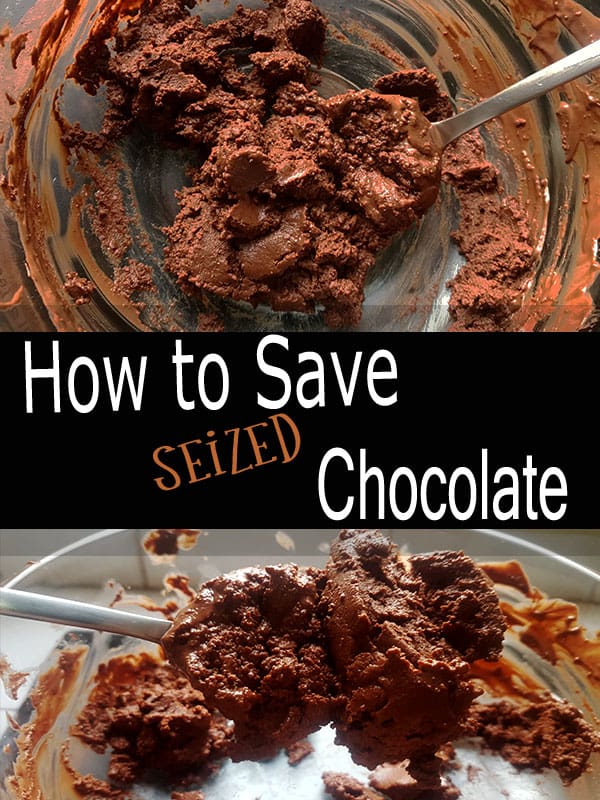Rescue Your Chocolate: Simple Steps to Fix Seized Chocolate

When melted chocolate is silky, smooth and free flowing it is hard to resist but when it seizes and becomes thick and sludgy it is a nightmare.
Chocolate is such a versatile food, but can also be very delicate. It can be mixed with so many other types of food and be used in so many different recipes, but, there is one thing that chocolate hates, and that is water. Have you ever been melting chocolate and all of a sudden, it becomes thick, stiff, gritty and difficult to stir? Well, it happened to me recently and this is why.
Why does chocolate seize?
Seizing occurs when moisture is added to chocolate. Chocolate is a mixture of fat (from cocoa butter) and dry particles (cocoa & sugar). When chocolate is melted, its main ingredients: cocoa powder, sugar, and cocoa butter, break up and disperse evenly, creating a smooth and fluid consistency.
However, when melted chocolate comes into contact with water, the dry particles become moist and begin to stick together, quickly forming a gritty, rough mass of chocolate.
If even a tiny amount of moisture is introduced, the liquid and the sugar will form a syrup to which the cocoa particles will cling, thereby creating grainy clumps. In fact, adding any cold liquids to melted chocolate can cause it to seize and form a grainy paste.
How much liquid it actually takes to trigger this reaction depends mostly on the amount of chocolate and its sugar content.
How to prevent chocolate from seizing?
Chocolate will seize if any liquid that contains water manages to find its way into the melted chocolate.

- So, when you work with chocolate, make sure that all your bowls and utensils are perfectly dry.
- Try to avoid using wooden spoons or boards, as they might retain moisture and impart it into your chocolate. If you have to use wooden equipment, try to dry it as much as possible.
- If you are using a double boiler to melt the chocolate, do not allow the water to boil as it might splash or steam into the chocolate. Also, wipe the bottom of the bowl before you pour the chocolate.
- Do not cover the chocolate with a lid as condensation can build up inside the bowl or pan and drip into the chocolate.
- If you want to change the colour of your chocolate, use an oil-based food colouring as other types may contain water.
- If you are dipping fruit or candy into chocolate, pat them dry first.
How to fix seized chocolate?

Unfortunately, if you are using the chocolate to make chocolate bars or as a coating, once it has seized it is too late. But all is not gone as you can put the chocolate to use in other ways. The seized chocolate can be used as a sauce, for drinking, or for any recipe where you need to add butter or liquid such as a ganache.
So, how to fix that seized chocolate…
Surprisingly, seizing is caused by water, but more water can actually fix it. If the melted chocolate has become thick and clumpy, adding more liquid will help to dissolve the dry particles (sugar and cocoa) and help it to become fluid again.
Add the liquid little by little and stir constantly until it becomes smooth again. So if you want to use seized chocolate to make a ganache, slowly pour in cream or milk and stir until you reach the desired consistency.

If you are making a recipe that requires liquid and it seizes, it’s either because you haven’t added enough liquid or you added the liquid cold which caused the chocolate to harden.
Although you may be able to save the seized chocolate for baking, once water has been added, it has been diluted and may impact the texture of your recipe.
But you may be able to save it.
I recommend slowly introducing extra melted cocoa butter, a tablespoon at a time, and stirring tenderly until the chocolate starts flowing again. If you don’t have any cocoa butter, you can use vegetable shortening or coconut oil instead. If there are still some grainy bits left, strain them out through a sieve. The chocolate may now be smooth enough to use to make cakes, brownies, mousse or any other baking recipes.
Overheating
Melting chocolate can be delicate work and if you go above certain temperatures you can also burn it. So it is not just moisture that you have to worry about. Chocolate may also seize and become stiff and dull if it has been overheated.
Your satiny, smooth chocolate can all of a sudden appear thick and muddy.
To prevent this from happening, ensure that you use a decent thermometer when melting chocolate and keep track of the temperature. Dark chocolate should never go above 120°F/48°C and milk and white chocolate 110°F/43°C.
Read this article to find out how to save overheated chocolate.












Leave A Comment